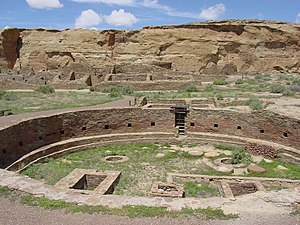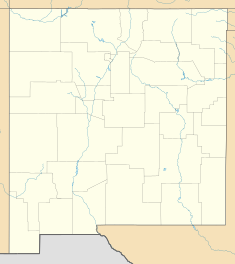
Back محمية تشاكو كالتشر التاريخية الوطنية Arabic Cañón del Chaco AST Çako Mədəniyyəti Milli Tarix Parkı AZ Чака (культурны нацыянальны гістарычны парк) BE Чако (национален исторически парк) Bulgarian Parc Històric Nacional de la Cultura Chaco Catalan Chaco Culture National Historical Park CEB Chaco Culture National Historical Park German Nacia Historia Parko de la Ĉako-kulturo EO Cañón del Chaco Spanish
| Chaco Culture National Historical Park | |
|---|---|
 Great kiva of Chetro Ketl | |
 Park map | |
| Location | San Juan County and McKinley County, New Mexico, US |
| Coordinates | 36°04′N 107°58′W / 36.06°N 107.96°W |
| Area | 33,977.8 acres (137.50 km2) |
| Architectural style(s) | Ancient Puebloan |
| Visitors | 41,594 (in 2022) |
| Governing body | National Park Service |
| Website | Chaco Culture National Historical Park |
| Official name | Chaco Culture |
| Type | Cultural |
| Criteria | iii |
| Designated | 1987 (11th session) |
| Reference no. | 353 |
| Region | Europe and North America |
| Type | historic district |
| Designated | October 15, 1966 |
| Reference no. | 66000895[1] |
Former U.S. National Monument | |
| Designated | March 11, 1907 |
| Delisted | December 19, 1980 |
| Designated by | President Theodore Roosevelt |
| Designated | December 19, 1980 |
| Designated | May 21, 1971 |
| Reference no. | 57 |
Chaco Culture National Historical Park is a United States National Historical Park in the American Southwest hosting a concentration of pueblos. The park is located in northwestern New Mexico, between Albuquerque and Farmington, in a remote canyon cut by the Chaco Wash. Containing the most sweeping collection of ancient ruins north of Mexico, the park preserves one of the most important pre-Columbian cultural and historical areas in the United States.[2]
Between AD 900 and 1150, Chaco Canyon was a major center of culture for the Ancestral Puebloans.[a] Chacoans quarried sandstone blocks and hauled timber from great distances, assembling fifteen major complexes that remained the largest buildings ever built in North America until the 19th century.[2][4] Evidence of archaeoastronomy at Chaco has been proposed, with the "Sun Dagger" petroglyph at Fajada Butte a popular example. Many Chacoan buildings may have been aligned to capture the solar and lunar cycles,[5] requiring generations of astronomical observations and centuries of skillfully coordinated construction.[6] Climate change is thought to have led to the emigration of Chacoans and the eventual abandonment of the canyon, beginning with a fifty-year drought commencing in 1130.[7]
A UNESCO World Heritage Site located in the arid and sparsely populated Four Corners region, the Chacoan cultural sites are fragile—concerns of erosion caused by tourists have led to the closure of Fajada Butte to the public. The sites are considered sacred ancestral homelands by the Hopi and Pueblo people, who maintain oral accounts of their historical migration from Chaco and their spiritual relationship to the land.[8][9] Although park preservation efforts can conflict with native religious beliefs, tribal representatives work closely with the National Park Service to share their knowledge and respect the heritage of the Chacoan culture.[10]
The park is on the Trails of the Ancients Byway, one of the designated New Mexico Scenic Byways.[11]
- ^ "National Register Information System". National Register of Historic Places. National Park Service. July 9, 2010.
- ^ a b Strutin 1994, p. 6.
- ^ Fagan 2005, pp. 50–55.
- ^ Fagan 2005, p. 35.
- ^ Fagan 1998, pp. 177–182.
- ^ Sofaer 1997.
- ^ Fagan 2005, p. 198.
- ^ National Park Service.
- ^ Sofaer & Dibble 1999.
- ^ "Foundation Document Chaco Canyon Culture National Park" (PDF). US National Park Service. August 2015. p. 8 Ongoing Cultural Connections.
- ^ Trail of the Ancients. Archived August 21, 2014, at the Wayback Machine New Mexico Tourism Department. Retrieved August 14, 2014.
Cite error: There are <ref group=lower-alpha> tags or {{efn}} templates on this page, but the references will not show without a {{reflist|group=lower-alpha}} template or {{notelist}} template (see the help page).

